Despite a couple of nasty tantrums and my screeching “but I don’t want to go”, in 1956, my family emigrated from Britain to Canada. I remember those first few days of school. Kids making fun of my accent, laughing at me because I pronounced it “larfing”. There was only one thing that saved me. There was another new immigrant, Ilio, who got twice the teasing I did. Ilio’s family had arrived in Canada from Italy on almost the same day as my family did and poor little Ilio was deposited into grade six with a one-word English vocabulary. “Hello.” “Hello.” “Hello.”
Neither Ilio nor I had a baseball glove or a hockey stick but Ilio had my most desired of all sports equipment. Ilio had a football, not a strangely shaped North American football, but a perfectly round football. Tony taught me the word calcio and I taught him the word soccer and, on Sundays, on his way home from church, he would knock on my door, say his favorite new English word, and we would continue on to his home to get the ball. But before we left for the schoolyard and argued who was going to be in goal, Ilio’s mother would insist on two things: That Ilio change out of his Sunday best and we eat some porchetta.
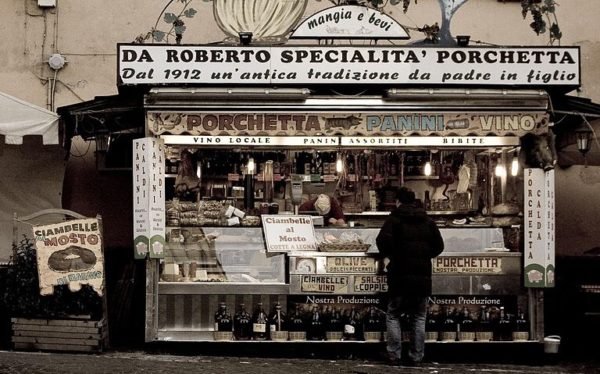
Ilio came from Treviso, a town just outside of Venice, and, apparently, porchetta had the same Sunday significance in Treviso as roast beef did in Britain. Ilio’s madre would thin slice the porchetta and serve it on crusty Italian bread with a yellow rind cheese and, despite me having a hearty English breakfast less than two hours before, I had no trouble leaving only crumbs on the plate.
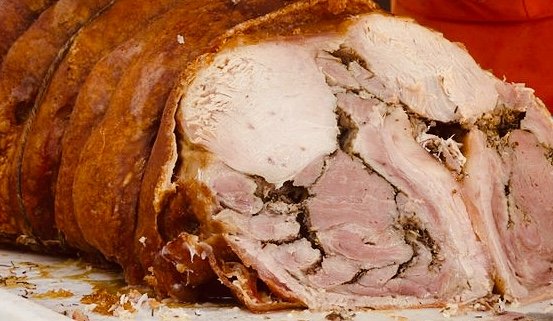
I have next to no memories of porchetta for the next few decades. It was not something you would ever find on the menus of Italian restaurants, only, I presumed, in immigrant’s homes. I have vague recollections of it in a Northern Ontario town called Sudbury and in a more well-known Pennsylvania town called Philadelphia but that’s about it.

Then, about ten years ago, a restaurant called Porchetta & Co. opened up in my second home of Toronto and suddenly porchetta was the trendiest thing between two slices of bread. It didn’t take long before butchers had it in their display cases and supermarkets had it in their flyers.
Marco Bruzzone hails from a town called Pescara. Pescara is in Abruzzo, about 400 kilometers south of the late Ilio’s hometown of Treviso but, in Pescara, porchetta is a Sunday tradition as well.
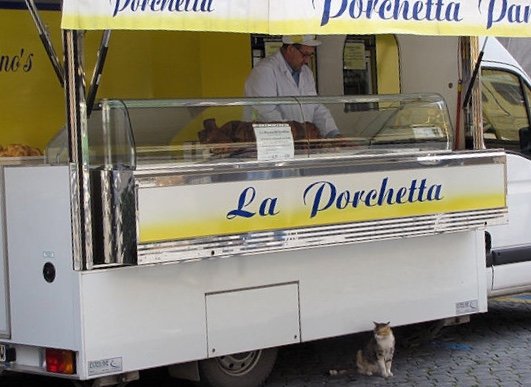
“On Sundays and holidays, these white-painted vans would come down from the mountains”, said Marco, “open up their sides, slice the porchetta up and put it on panino. I loved those days.”
Like llio and I, Marco Bruzzone emigrated to the new world. He settled in Chicago but, like me, somehow ended up in San Miguel de Allende, Mexico. These days he’s the chef/owner of San Miguel restaurant Fiamma and, these days, he’s serving porchetta.
“I wanted to change things up a bit”, said Marco, “so on Thursday I’m doing seafood and on Tuesday I’m doing porchetta.”
Before I describe Marco Bruzzone’s porchetta, I should describe porchetta in general.
Let’s start with the pronunciation. It is not porchetta as in the train, the choo-choo. It is porchetta as in the bird, the cuckoo. I’ve even seen it spelled porketta.
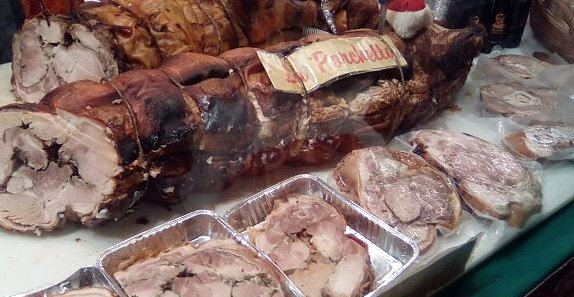
Though the dish is now common throughout Italy, Marco Bruzzone told me it probably had its origins in the central part of the country where most of the hogs are raised and, on the day I went to Fiamma to check out Marco Bruzzone’s porchetta, he pulled out a book with a map of Italy, circling Rome, Lazio, Umbria and his native Abruzzo with his finger.

The dish begins with the carcass of a pig, preferably a young one, about a year old, being totally deboned. It is then stretched out, smeared with a variety of spices, rolled into a log and then roasted.

“I have a great carniceria, two brothers that do all the butchering for me”, said Marco, “I want the belly for my porchetta. Except for the legs that go for prosciutto, the belly is the best, the very best.”
“Porchetta Abruzzese, the style I do, is slow roasted with rosemary…a lot of rosemary, garlic…a lot of garlic as well, oregano and, most importantly, black pepper. For the liquid, I use white wine.”

Porchetta is traditionally done in a wood oven so it’s very convenient that Marco Bruzzone has his mezquite-fired pizza oven at his disposal. He wraps the pork tightly in foil and roasts it for one and half hours; then Marco does something that is far from traditional, something I have never heard of any chef doing, perhaps something no other chef does. Chef Bruzzone adds a mixture of red wine, commercially-bottled barbecue sauce, honey, and more rosemary and puts it back into the brick oven for another hour.
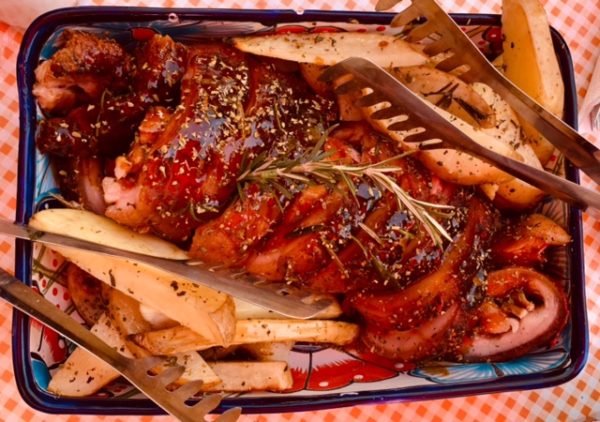
At the same time as he puts his porchetta back in to the wood-fired oven, the chef puts in a tray of big yellow-fleshed potato wedges which, again not like any other chef I’ve ever known, he serves with inch-thick slices of his porchetta.
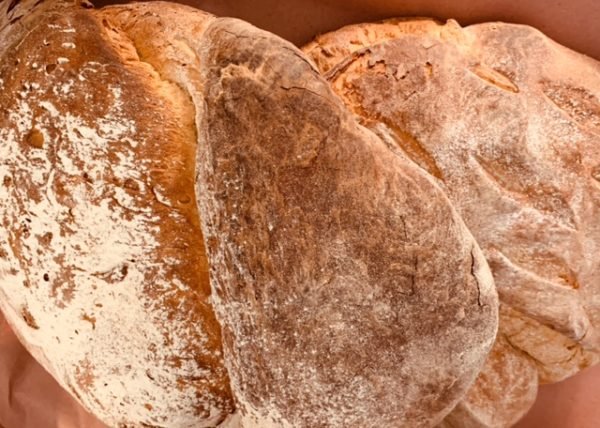
Now, if you are like me and are used to your porchetta being tucked between two fat slices of crusty Italian bread, Chef Bruzzone has an answer for that as well. Before the porchetta goes into the oven, some of the fattest mounds of dough you’ve ever seen go in and come out as loaves bigger than most breadbaskets.
So how is Fiamma’s porchetta? Well some chefs remove the skin from their pork. Some chefs trim the fat way, way back. But not Marco. So if you’re an I love lean person you probably won’t love Chef Bruzzone’s porchetta.
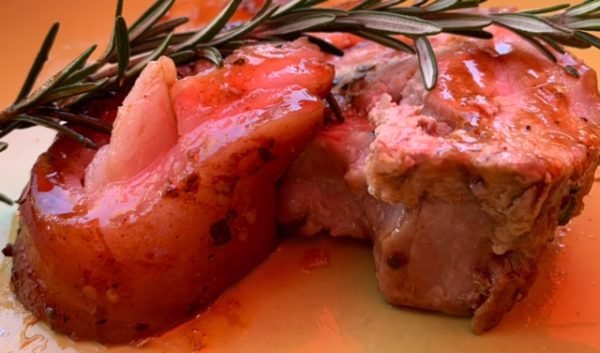
But if you want a moist and tender slice of pork, wrapped in crispy skin and bathed in aromatic herbs and spices that is a part of Italian culinary history, you’ll be like me, going back to Fiamma for more, very soon.

Pizzeria Fiamma is located at Carretera Salida a Celaya #6 in San Miguel de Allende, Mexico. The restaurant is open from Noon to 10:00 pm, seven days a week. Porchetta is Tuesday’s specialty.

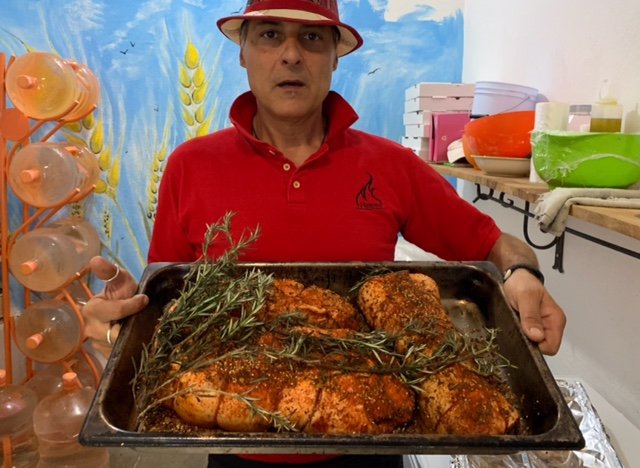
Love the post! It made me “larf” while I was drooling!
I would love to try it but this guy is a pretty rude one for being in this business. I was with 3 other friends …. one a local woman, and the way he spoke to her was unbelievable. I don´t even walk past his place because of this occurrence….and I´ve heard other stories about him as well….it´s a shame.
Not true! Marco is one of the most charming, and considerate people in the world! My husband and I, and our friends go there regularly!!! It’s a wonderful place with delicious food!
I agree with poster. I like the food but have also found both the owner and one of the waiters extremely rude. Won’t go again with that kind of attitude.
I am so sorry for my colesterol level but this is a wonderful artisanal dish full of memories and sooo goooood…! Had it twice with Marco at his cosy and romantic terrace and I will be back for more
Auguri Marco y Mariana
Great article, Glenn. You’ve got me sitting here drooling. Gotta make it over to Fiamma very soon!
Great post. My favorite dish while vacationing in Italy ( beside the pizza) was porchetta. If it’s anything like that I will be in heaven!
Glen,
Thanks for your columns on good food in SMA. I will be there in February and intend to try out your recent recommendations. As a long time visitor, I would be very interested in hearing from you on the reported recent increase of violence and robbery. Has it had any impact on your feeling of security or walking about after dark?
Regards,
Bart St. John-Smith
Ottawa
I still feel very secure but I know others who don’t. Almost all of the killings have been cartel A kills a member of cartel B, then cartel B kills two cartel A’s. I don’t think there has been a single tourist or expat involved. I’m guessing things like home break-ins and purse snatchings are at about the same level as always. And it’s still the very best town in the world.
Marco and Maria and the staff make me feel at home and are always polite and helpful. Love the food, ambiance and will keep going back for more!
….served with a side of garlic mashed potatos I presume….
Wood oven roasted. Maybe even better.